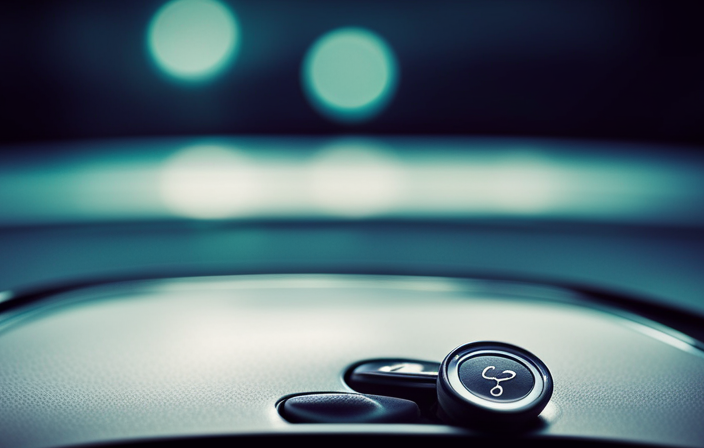Get ready, everyone! Today, I will demonstrate how to expertly reset your cruise control.
We’ve all been there, cruising down the highway, enjoying the open road, when suddenly, our trusty cruise control decides to take a vacation of its own. Well, fear not, because I’ve got your back.
In this article, I’ll guide you through the precise steps to reset your cruise control system and get back to smooth sailing in no time.
- Understanding the inner workings of your cruise control and locating the magical button or lever.
- Turning off and restarting your vehicle.
- Pressing and holding that button or lever to bring your cruise control back to life.
- Troubleshooting common issues and where to find additional help if needed.
So, sit tight and let’s get your cruise control back on track!
Key Takeaways
- Restarting the vehicle is necessary after turning off the cruise control.
- To reactivate the cruise control, press and hold the cruise control button or lever.
- Setting the desired speed involves using the cruise control buttons or lever to adjust and lock in the desired speed.
- Troubleshoot cruise control issues by adjusting speed and distance settings or referring to the vehicle’s manual for specific instructions.
Understand Your Cruise Control System
Imagine yourself sitting in the driver’s seat, feeling the smooth hum of the engine as you grip the steering wheel, ready to understand how your cruise control system works.
To gain a complete understanding of your cruise control features, it is important to dispel common misconceptions about this technology. Contrary to popular belief, cruise control does not brake or accelerate your vehicle automatically. Instead, it maintains a consistent speed set by the driver, allowing them to relax their foot on the gas pedal.
Most cruise control systems are equipped with buttons or a lever conveniently located on the steering wheel or the stalk behind it. These controls enable you to activate and adjust the cruise control settings effortlessly.
Understanding the basic concepts of cruise control will now transition us into the next section, where we will explore how to locate the cruise control button or lever.
Locate the Cruise Control Button or Lever
To initiate the resetting process, first locate the button or lever responsible for activating the cruise control feature. This button or lever is typically found on the steering wheel, near the driver’s thumb or on the side of the steering column.
Once you have located the cruise control button or lever, engage cruise control by pressing or pulling it. This action will activate the cruise control system, allowing you to set a desired speed for your vehicle.
To adjust the speed, use the control buttons typically located on the steering wheel or the control lever.
It is important to note that the location of these buttons may vary depending on the make and model of your vehicle.
Now, let’s move on to the next section where we will discuss how to turn off the cruise control.
Turn Off the Cruise Control
To deactivate the cruise control, simply locate the button or lever you used to engage it and press or pull it again, bringing a sense of relief as you regain full control of your vehicle. Turning off the cruise control is a straightforward process, but it’s important to know exactly where the button or lever is located in your car. It is typically found on the steering wheel or the stalk behind the steering wheel. Once you have located it, press or pull it to turn off the cruise control. If you are having trouble finding the button or lever, consult your vehicle’s manual for specific instructions. Remember, if you encounter any issues with your cruise control, such as it not engaging or disengaging properly, refer to the cruise control troubleshooting tips. After turning off the cruise control, you can restart your vehicle and continue your journey.
Restart Your Vehicle
Restarting your vehicle after turning off the cruise control is a quick and simple step that allows you to get back on the road with ease. To restart your vehicle:
-
Make sure you come to a complete stop and shift the transmission into park (P) or neutral (N).
-
Turn the ignition key to the off position and remove it from the ignition switch.
-
Wait for a few seconds before reinserting the key and turning it to the on position.
-
Press the brake pedal and start the engine by turning the key to the start position.
Once the engine is running, you can press and hold the cruise control button or lever to reactivate the system. If you encounter any issues during the restart procedure, refer to the troubleshooting tips in your vehicle’s owner’s manual.
Transitioning into the subsequent section, let’s now explore how to press and hold the cruise control button or lever.
Press and Hold the Cruise Control Button or Lever
When you’re ready to reactivate the cruise control, simply hold down the button or lever and let it take the wheel while you sit back and relax, like a captain guiding their ship through calm waters. This action will release and reset the cruise control, allowing you to resume your desired speed.
However, if the cruise control doesn’t engage after holding the button or lever, there are a few troubleshooting tips you can try. First, make sure your vehicle is in the appropriate gear for cruise control activation. Additionally, check for any warning lights or error messages on your dashboard that may indicate a malfunction. If all else fails, consult your vehicle’s manual or contact a professional for further assistance.
Now, let’s move on to the next section where we’ll discuss how to set your desired speed.
Set Your Desired Speed
To set your desired speed on your cruise control system, follow these easy steps:
- Locate the cruise control button or lever on your vehicle’s steering wheel or dashboard.
- Press or pull the button or lever to activate the cruise control system.
- Use the increase or decrease speed buttons, usually located near the cruise control button, to adjust your desired speed.
- Once you’ve reached your desired speed, release the increase or decrease speed button to lock it in.
With these simple steps, you can effortlessly set your cruise control to your preferred speed and enjoy a smooth ride.
Now, let’s move on to testing the cruise control functionality to ensure everything is working perfectly.
Test the Cruise Control Functionality
To ensure that your cruise control is functioning properly, it’s important to test its functionality. This will help you troubleshoot any potential problems that may arise.
To begin, make sure you are in a safe and open area with minimal traffic. Activate the cruise control by pressing the designated button on your steering wheel. Once engaged, the cruise control should maintain the desired speed you previously set. Pay close attention to any fluctuations or inconsistencies in the speed.
If you notice any issues, such as the speed not being maintained or sudden acceleration, it may indicate a problem with the cruise control system. In such cases, it’s recommended to consult your vehicle’s manual or seek professional assistance.
Now, let’s move on to the next step and learn how to adjust the speed and distance settings.
Adjust the Speed and Distance Settings
Make sure you’re in complete control of your driving experience by adjusting the speed and distance settings on your vehicle’s cruise control. This allows you to customize your cruise control to suit your preferences and driving conditions.
Here are three key adjustments you can make:
-
Adjusting sensitivity: By increasing or decreasing the sensitivity of your cruise control, you can fine-tune how quickly it responds to changes in speed. This helps maintain a steady and comfortable driving experience.
-
Troubleshooting problems: If you encounter issues with your cruise control, such as it not engaging or disengaging unexpectedly, adjusting the speed and distance settings can help troubleshoot the problem. Sometimes, a simple adjustment can resolve the issue and get your cruise control back on track.
Now that you know how to adjust the speed and distance settings on your cruise control, let’s move on to troubleshooting common cruise control issues.
Troubleshoot Common Cruise Control Issues
If your cruise control is not functioning properly, troubleshooting common issues can help identify and resolve the problem.
Imagine you are driving on the highway and your cruise control suddenly stops maintaining a steady speed, causing your vehicle to accelerate and decelerate unpredictably.
To troubleshoot this issue, start by checking the speed sensor, which is responsible for detecting the vehicle’s speed. Ensure that it is clean and free from any debris or damage.
Additionally, inspect the cruise control module for any loose connections or faulty wiring.
Another common malfunction is a faulty brake pedal switch, which can prevent the cruise control from engaging.
If these troubleshooting techniques do not resolve the issue, consult your vehicle’s manual or contact a professional for further assistance.
Consult Your Vehicle’s Manual or Contact a Professional
To troubleshoot common cruise control issues, it is important to consult your vehicle’s manual or contact a professional. The manual will provide specific instructions tailored to your vehicle’s make and model, making it an invaluable resource. If you are unable to find a solution in the manual, contacting a professional is the next step. They have the expertise and experience to diagnose and resolve any issues you may be facing with your cruise control.
When contacting a professional, be sure to provide them with as much information as possible about the problem you are experiencing. This will help them troubleshoot the issue more efficiently. Additionally, they may ask you to bring the vehicle in for further inspection or provide guidance on potential solutions over the phone.
In the table below, you can find some common cruise control issues and possible troubleshooting steps:
| Issue | Troubleshooting Steps |
|---|---|
| Cruise control not engaging | – Check if the cruise control button or switch is turned on. – Ensure the vehicle is traveling at the minimum speed required. |
| Cruise control not maintaining speed | – Check for any loose or damaged vacuum hoses. – Inspect the throttle linkage for any obstructions. |
| Cruise control disengaging unexpectedly | – Check if the brake pedal switch is functioning properly. – Inspect the cruise control module for any faults. |
Remember to always prioritize safety and follow the guidance of a professional when troubleshooting your cruise control system.
Frequently Asked Questions
How do I reset my cruise control on a specific make and model of vehicle?
To reset the cruise control on a specific make and model of vehicle, start by troubleshooting any issues. Check the owner’s manual for instructions on locating the cruise control button and follow the step-by-step process for resetting it.
What are some common reasons why my cruise control may not be working?
Some common troubleshooting steps for a cruise control malfunction include checking the fuse, inspecting the wiring and connections, ensuring the vehicle speed sensor is functioning properly, and verifying that the brake pedal switch is working correctly.
Can I reset my cruise control without restarting my vehicle?
To reset cruise control without restarting the vehicle, troubleshoot the issue by checking for common reasons why it may not be working. Look for faulty wiring, blown fuses, or a malfunctioning cruise control switch.
Is it possible to reset my cruise control settings to the default factory settings?
To reset your cruise control settings to the default factory settings, locate the cruise control button on your vehicle’s dashboard. Press and hold the button for approximately 10 seconds until the settings are reset. However, be aware of potential risks and consider troubleshooting tips for any cruise control issues you may be experiencing.
Are there any safety precautions I should take before resetting my cruise control?
Before resetting cruise control, take safety precautions. Park the vehicle on a level surface, engage the parking brake, and turn off the engine. Consult your vehicle’s manual for specific steps to reset the cruise control.
Conclusion
As I followed the steps to reset my cruise control, I couldn’t help but feel a sense of relief wash over me. It was as if the weight of the world had been lifted off my shoulders.
The precise instructions and troubleshooting tips provided in this article allowed me to regain control and confidence in my vehicle’s functionality. I now feel equipped and empowered to tackle any cruise control issues that may arise in the future.
Meet Asra, a talented and adventurous writer who infuses her passion for exploration into every word she writes. Asra’s love for storytelling and her insatiable curiosity about the world make her an invaluable asset to the Voyager Info team.
From a young age, Asra was drawn to the power of words and their ability to transport readers to far-off lands and magical realms. Her fascination with travel and cultures from around the globe fueled her desire to become a travel writer, and she set out on a journey to turn her dreams into reality.











